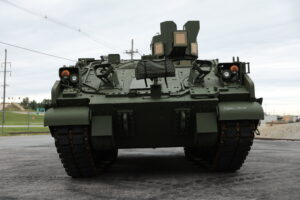HUNTSVILLE, Ala. — After providing two hybrid-electric Bradley vehicles for Army testing, BAE Systems has said it’s now planning to design a similar system for its Armored Multi-Purpose Vehicle (AMPV).
“The [Bradley hybrid-electric vehicle] approach we’ve taken is scalable. We’re moving it to AMPV. So we have an [AMPV hybrid-electric vehicle] program that we’re starting to design right now, which is moving this to AMPV. And [we’re] talking to the Army about when and if we do that next. So we’re pretty excited about that,” Jim Miller, BAE Systems’ vice president of business development for combat mission systems, told reporters during a briefing at the Association of the United States Army’s Global Force Symposium.

The Army’s Rapid Capabilities and Critical Technologies Office (RCCTO) is leading the research and development effort with the two hybrid-electric Bradleys, which has already accumulated 500 miles across the two test vehicles and is intended to help inform the service’s combat vehicle electrification pursuits.
Lt. Gen. Robert Rasch, the Army RCCTO director, told Defense Daily he hopes to build on the Bradley initiative and start additional hybrid-electric prototyping efforts in fiscal year 2024, to include “primarily looking at AMPV [and] maybe Stryker” to further prove out the technology.
“Army leadership is very in tune with the potential operational utility of hybrid-electric. So we did the Bradley. We also have some Humvee efforts going on right now. So we’ve got a wheeled chassis and a tracked chassis. At the time, Bradley was done because I could get a Bradley vehicle and, quite frankly, it’s a challenging environment. The Bradley’s got a very small engine compartment, so if I can do a hybrid-electric [drive] in it then it might scale out to other things,” Rasch said during an interview at AUSA’s Global Force Symposium.
BAE Systems has discussed the potential hybrid-electric AMPV with RCCTO, Miller noted, adding there’s a potential to scale the company’s hybrid-electric drive capability to vehicles that are up to 40 to 60 tons “with some minor adjustments.”
Miller said BAE Systems has taken a Modular Open Systems Architecture-based approach in its work with QinetiQ on the hybrid-electric capability to allow for potential application across different platforms.
“It gives us a chance to upgrade our vehicles in the future. As subcomponents evolve, we can replace the engine with a fully-electric engine or a hydrogen engine and those kinds of new batteries. It gives us a great opportunity to do that in that future,” Miller said. “So that’s the idea. If you’ve proved it in a Bradley, now prove that you can move it to another vehicle and make it work.”
Miller previously told Defense Daily the company is planning to build all of its future combat vehicles with capability for hybrid-electric power (Defense Daily, Oct. 11 2022).
BAE Systems and the four other firms vying for the Army’s Optionally Manned Fighting Vehicle program, which is intended to find a Bradley replacement, are all offering hybrid-electric designs (Defense Daily, Nov. 1 2022).
Rasch said RCCTO’s prototyping effort will help inform requirements for ruggedizing hybrid-electric drives for military utility, and cited the Army’s interest in the operational benefits for silent watch and increased exportable power.
“Some people are under the false assumption that this is just about gas savings and nothing could be further from the truth. It really is about the operational utility of having the ability to do that last kilometer, as you’re trying to move your fighting vehicle up for the final objective, and to have it go on electric-only where it’s silent. A silent tracked vehicle or a silent wheeled vehicle without an engine is a combat multiplier on the battlefield, because right now you can hear those vehicles coming from miles away,” Rasch said. “If I can harness some of that additional power that hybrid-electric vehicles can provide, I can put more things or more capabilities on that platform to make it more lethal and also more survivable.”
The Army recently achieved the First Unit Equipped Milestone for AMPV, with BAE Systems now moving portions of its production work to other facilities to ensure its York, Pennsylvania manufacturing site has expanded capacity as the Army works toward annually delivering “a brigade and a half” worth of the vehicles within two years (Defense Daily, March 31).